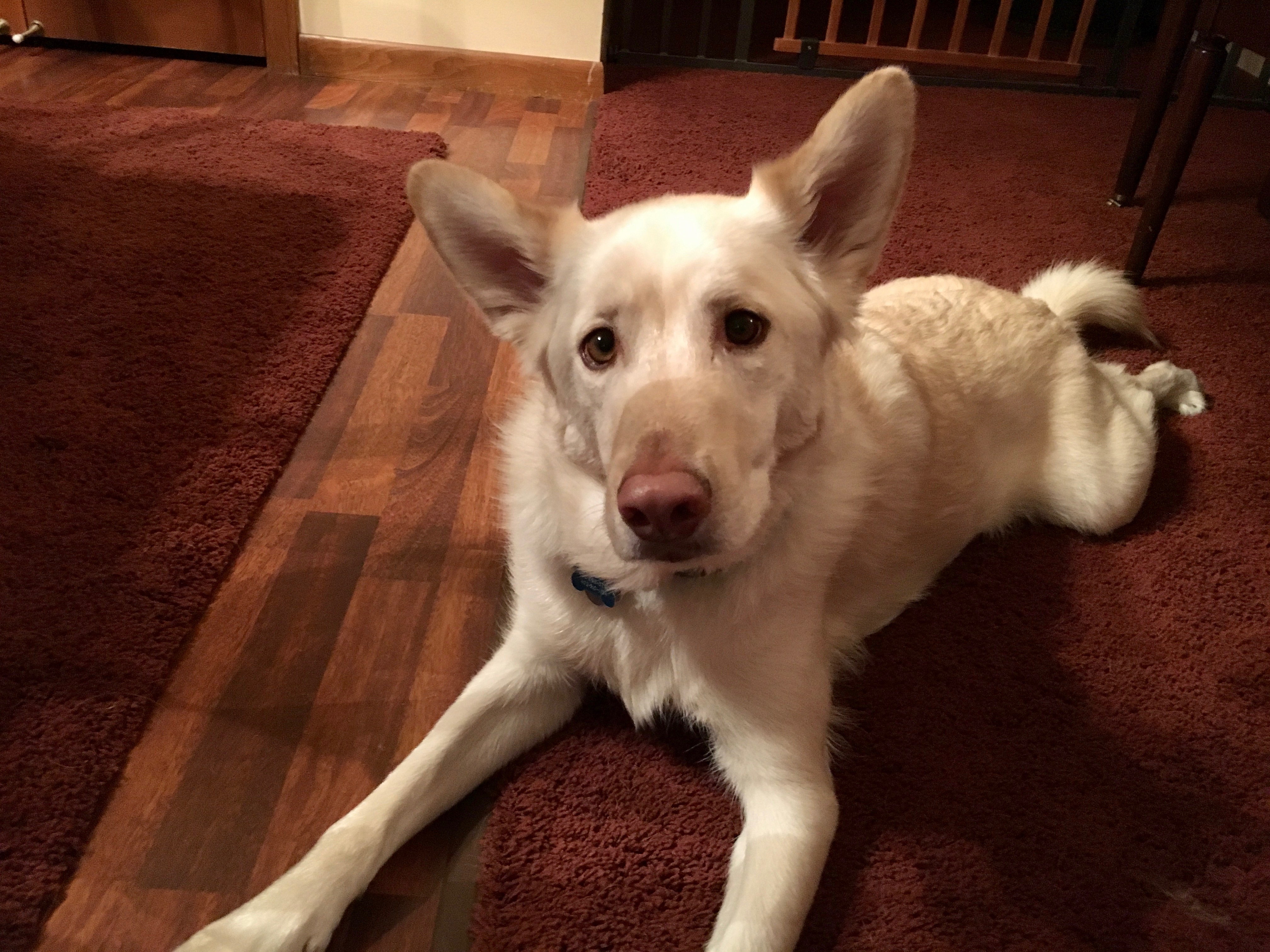Tips to Help a Excited and Mildly Insecure Dog Feel Comfortable When Guests Arrive
By: David Codr
Published Date: January 18, 2018
For this Omaha dog training session we worked with an excited and slightly insecure 2 year-old White German Shepherd / Lab mix named Ike; teaching him to feel better when guests arrive and training him to focus to help stop him from getting into trouble like jumping, nipping at hands when playing fetch and nipping to demand attention.
As soon as I came inside, Ike’s body language was telling me he was not comfortable with me; he was leaning over himself towards me (trying to keep his distance), breathing heavy, had wide eyes, a stiff body language and was displaying an anxious energy. These are common behaviors from a dog who is not comfortable around a new person.
Despite Ike communicating he was unsure about my arrival, later in the session his guardian mentioned he had never settled down or warmed up for a guest as quickly as he did for me. I was able to get this result by recognizing his discomfort and doing a few things to help him feel more comfortable.
Here are a few tips to help a dog feel more comfortable when meeting new people.
-
- I tossed a few high value treats towards him while I remained in the doorway. This allowed me to create a positive association with him while at a distance.
- I waited at the door until he had given me a good sniff. This is a very polite way to enter a dog’s home, provided the dog isn’t jumping on the person or offering another unwanted behavior.
- I remained still while he sniffed me, giving him an opportunity to gain confidence in my presence. Moving when an anxious dog is checking you out can spook them.
- I refrained from reaching out to pet him. If you meet a nervous dog, waiting for them to come to you and initiate contact can help them feel confident around you.
If you have a dog who gets anxious when guests arrive, following these steps can help it gain confidence in the situation
Once we sat down to discuss the situation, Ike goofy, playful energy started to show. He started bringing me toys to play with him. This is a polite social behavior so I asked his guardian if he liked to play fetch. While he did like the activity, his guardians had been pulling the item from his mouth instead of training the dog to drop it first.
I spent a few minutes going over how to teach a dog to drop which will be helpful as Ike liked to steal things to get attention. When you have a dog who takes these things, teaching them to drop is immensely helpful.
After teaching Ike to drop, I showed his guardian how to teach him to fetch and drop the item. In less than a minute I had Ike fetching for me with my rules; dropping the ball when he brought it back then sitting to ask me to throw it again.
I recommended that the guardian take Ike out for a game of fetch anytime he started stealing things, chewing on the carpet or offering other unwanted behaviors. I also suggested she increase his daily exercise and track his progress by grading the day, then varying the exercise he got the next day. Eventually the guardian should find the right amount of exercise to keep Ike from causing mischief due to boredom (he is one smart dog).
I also recommended his guardians look into taking him to dog day care a few times a week. The social interaction and physical activities will both be very beneficial for him,
Next I turned my attention to Ike’s habit of stealing things or getting into “trouble.” Because dogs crave attention and don’t see bad attention as a negative in the way that we do, Ike had learned that stealing things or misbehaving was the quickest way to get attention. This is a common dog behavior problem I have helped hundreds of guardians stop.
I went over ways for his guardians to reward Ike for desired behaviors as well as a way to stop him from demanding attention and sit to ask for it instead.
I have found a great way to get a dog to stop getting into trouble is to train them to respond to a redirect command. My preferred way to do this is to train a dog to focus.
By teaching a dog to focus on command, the guardian has a powerful tool that can be used to redirect their attention before they get into trouble. It will be important the guardian practice the Focus a few times a day while progressively increasing the duration to make it more challenging.
Because he is so smart, it would be a great idea for the guardian to get into a habit of training the dog with a new trick or command each week. This will help to mentally stimulate Ike and give his guardians other ways to redirect him.
Teaching Ike some new tricks and commands will also boost his confidence and self esteem. This will help with many of his reactivity behaviors (barking, jumping, nipping).
I must say I really enjoyed working with Ike. He has a nice playful energy. Most of his unwanted behaviors were really a case of miscommunication (attention for bad behaviors), needing more stimulation / exercise and not being rewarded for desired behaviors as vehemently as he was correcting for those that were unwanted.
To help the guardians remember all the dog behavior tips I shared in this in home dog training session, I shot a roadmap to success video you can check out below.
Categorized in: Dog Behavior


